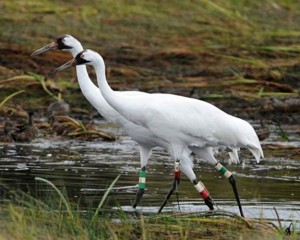Posted by: Jim Williams under Bird conservation Updated: September 29, 2011 – 5:26 PM
Update on Whooping Crane population as distributed by Robert Russell, bird biologist with the U.S. Fish and Wildlife Service in St. Paul.
*****
The Aransas-Wood Buffalo National Park (Canada) population (AWBP) of Whooping Cranes rebounded from 263 in the spring of 2010 to 279 in the spring, 2011. With approximately 37 chicks fledged from a record 75 nests in August 2011, the flock size should reach record levels of around 300 this fall. Threats to the flock in Texas including land development, reduced freshwater inflows, the spread of black mangrove, the long-term decline of blue crab populations, sea level rise, land subsidence, and wind farm and power line construction in the migration corridor all continue to be important issues.
Twelve Whooping Crane juveniles were captured in Wood Buffalo National Park in August 2011 for attachment of radio-tracking devices, bringing the total number of radioed birds to 23. The radio signals are used to track movement of the birds.
Ten captive-raised Whooping Cranes were released in February, 2011 at White Lake, Louisiana where a wild non-migratory flock had resided up until 1950. Seven of the birds were alive after the first seven months of the project.
Production in the wild from reintroduced flocks in 2011 was again very disappointing with no chicks fledged in Florida or Wisconsin. Incubation behavior in Florida and nest abandonment in Wisconsin continued to be the focus of research. Data collected so far in Wisconsin indicates that swarms of black flies play some kind of role in a majority of nest abandonments.
The captive flocks had a good production season in 2011. Approximately 17 chicks were raised in captivity for the non-migratory flock in Louisiana, and 18 chicks are headed for Wisconsin (10 for the ultralight project at the White River marshes, and 8 for Direct Autumn Release at Horicon National Wildlife Refuge). Approximately four chicks of high genetic value were held back for the captive flocks.
Including juvenile cranes expected to be reintroduced this fall, flock sizes are estimated at 278 for the breeding flock in Canada, 115 for the Wisconsin to Florida flock, 20 nonmigratory birds in Florida, and 24 in Louisiana. With 162 cranes in captivity, the total world population of Whooping Cranes is 599.
Below is a pair of Whooping Cranes photographed last summer at Necedah National Wildlife Refuge in Wisconsin.


